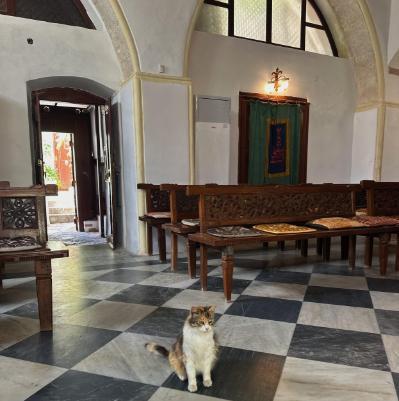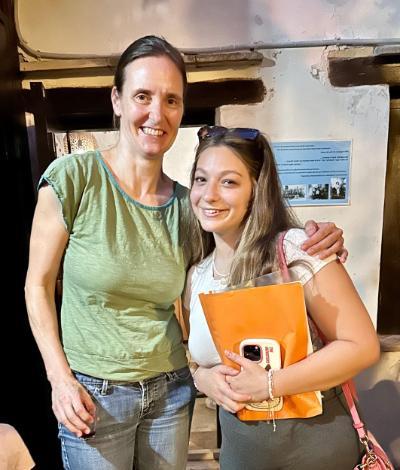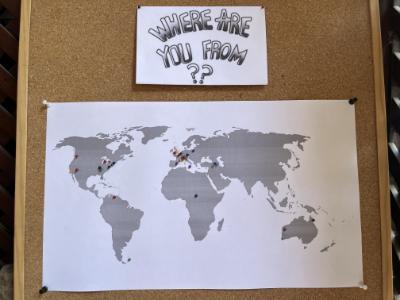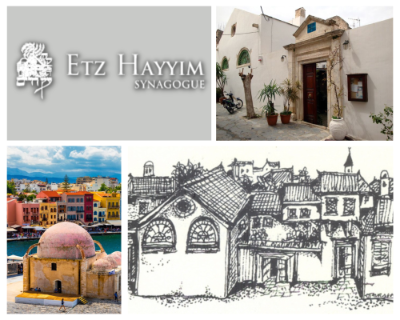LMU Jewish Studies Internship in Crete, Greece
LMU Jewish Studies is very excited to offer the 3rd year of our internship in Chania on the Island of Crete in Greece.
Due date: February 01, 2025
A 1 page letter of interest is required. Include minor and or major, interests and activities that make you suited for this internship. What you think you will add to the internship, what you think you will gain from this internship, and why you are the right candidate for this internship. Please send the letter to Dr. Holli Levitsky.
Two candidates will be chosen to intern in the summer of 2025. One student will be from Jewish Studies, and the other will be from Classics or Jewish Studies.
One student will intern for 4 weeks in June, and the other will intern from mid-July through mid-August.
For this internship, the student will travel to and live in Chania, a city on the Greek island of Crete. The intern will help with ongoing efforts to memorialize the Jews of Crete, a community with ancient roots and a proud history of religious and cultural achievements. Working closely with the staff and volunteers of Etz Hayyim synagogue, and the associated historical center, the student will assist in the revival and growth of the Jewish community in diverse ways, including research at archives and area sites, leading tours for visitors, curating social and print media, and more.
During their internship, students are expected to post a weekly blog of their experiences for the LMU Jewish Studies website. Upon their return to campus, students will complete their work and present their project at a program co-sponsored by the Jewish Studies and Classics departments.
About Etz Hayyim Synagogue: Since 2010, Etz Hayyim has been operated by a non-profit organization in cooperation with the Central Board of Jewish Communities in Greece (KISE). This non-profit organization is registered as a charity in Greece and, because Etz Hayyim does not receive any public funding, it raises funds for the maintenance of the synagogue and for the various religious and cultural events to ensure its long-term preservation. Two decades after its rededication, Etz Hayyim has become a fixture in the religious and socio-cultural life of Hania as a place of prayer, study, recollection and reconciliation. It is an active, non-denominational synagogue used for celebrating various Jewish holidays and non-religious cultural events including lectures, concerts and exhibitions. Its small team of staff and volunteers undertake ongoing research into the history of Cretan Jews at the same time as engaging both local and international school groups and teachers as part of the synagogue’s educational outreach program.
Student Internship Blog-Anna Tullie- Summer June 2024
Week 1
Prior to arriving in Chania, I was extremely nervous. However, my fears went away when I started my first day at Etz Hayyim. Arriving at Etz Hayyim synagogue, I was immediately met with open arms. My coworkers were not only extremely helpful when it came to learning the duties of my position, but they were also incredibly kind and patient with me, as I had quite a lot of questions. Now nearing the end of my first week in Chania, I already feel like I am a part of the Etz Hayyim family. I now look forward to the Hebrew lessons one of my coworkers has taken the time to give me, and a delicious home-cooked lunch my coworkers and I have together every weekday.
I am fascinated by the island of Crete’s rich history, especially its history surrounding the Romaniote Jewish community (Greek-speaking Jewish community). I have learned that the Romaniote community, after WWII, is very small. I found all of the information I have learned about the Romaniote community to be extremely eye-opening, as in my American education, I have not had the opportunity to learn about them. The entire Romaniote community in Crete perished during WWII, and at Etz Hayyim, our team strives to research their history and educate others about the Romaniote community in order to keep their memory and stories alive. My step-grandfather is Romaniote, which is a reason why I was so interested in this internship to begin with, as I wanted to learn more about his history. Upon working at Etz Hayyim, I have learned that having any connection to this community is not only rare, but extremely important. Knowing about the Romaniote community gives me the ability to inform others about their community and keep their memory alive. During my first week in my internship, I have already started to educate others about the Romaniote community. Only 3 days after my arrival in Chania, I already began giving tours to visitors about the history of Etz Hayyim, and about the Romaniote community in Crete. In the next few weeks here in Chania, I am excited to spend more time with my coworkers, while learning more about the Romaniote community through my own research, information from my coworkers, and through resources at Etz Hayyim.

Week 2
My second week working at Etz Hayyim was certainly hectic, but it was nothing less than incredible. As many of our staff members were working on setting up Etz Hayyim’s exhibition, myself and two of my coworkers, Milan and Finn, were in charge of cooking lunch, and giving tours at the synagogue. Although I did not cook (due to my lack of culinary skills), I gave a lot of tours. Giving tours every day at work has not only fulfilled me as I am educating people from all over the world about the history of Romaniote people, but it also has helped me to continue to learn more about Romaniote history. Every time I give a tour, I learn a little bit more. As I want
to be able to give the best tours that I possibly can, I make an effort to confirm with my coworkers that everything I'm saying in my tours is correct, and I try to make sure that there isn’t any important information I'm leaving out. Also, each time the tourists ask me a question that I may not know exactly now to respond to, I am challenged to think critically about Romaniote history. As Etz Hayyim is one of very few places where one can learn about Romaniote history in Greece, my role as a tour guide is incredibly important. The tourists that come through the door have probably never heard of the Romaniote community, and the information that I give
them may be the only information they will ever know about the Romaniote community. Due to this, I feel an immense amount of honor to be able to keep the history of Romaniote people alive. I cannot wait to learn more from my step-grandpa about his history and his culture, and I also can't wait to tell him about what I have learned about his history during my time in Chania. I also have begun promoting Etz Hayyim on social media. Using the Tiktok page thatNoah made last year, as of today I have posted 7 Tiktoks during my time at Etz Hayyim!
I hope that the Tiktoks that I have posted reach tourists visiting Chania, so that Etz Hayyim will receive even more visitors. The highlight of my second week at Etz Hayyim was definitely the opening night of our exhibition, “Faces From Our Past” at KAM Center of Mediterranean Architecture. The exhibition was even better than I anticipated. Before the opening of the exhibition, there were speeches from board members and researchers, and fantastic musical performances of original Kaddishs, by musician Emanuel Vahl. Our historians from Etz Hayyim, Christos and Giannis, as well as the director of Etz Hayyim, Anja, have been working tirelessly over the past few weeks to make sure the exhibition is the best it can be, and it truly was. The photos and the stories displayed in the exhibition about those who drowned during the sinking of the Tanais, are haunting, and incredibly impactful. Seeing the faces of those who died, alongside their stories, puts things into perspective, and makes you feel all of the devastating emotions that it should make you feel. The moment that stuck with me the most from the exhibition, was the presence of a survivor of WWII whose family hid in Athens during the events of the Tanais. A photo of him as a child was on display in our exhibit, and seeing him stand beside that photo now, in his old age, after all he has been through, was beautiful. (I have attached this picture below). Seeing this survivor gave me hope for the future of the Romaniote community. Although they have suffered immensely, I know that as long as there are people willing to tell their story, their history will never be forgotten. I am happy to be someone who has the ability to tell their story.
-400x537.jpg)
Week 3
Following its opening on Sunday, June 16th, Etz Hayyim’s exhibition, “Faces From Our Past” was completely packed all week. Some days, we even had around 400 visitors. Working at the exhibition was an incredible experience for me. Although working at both the synagogue and the exhibition all week was very tiring, I felt that the experience was rewarding enough to offset the sleepiness I may have felt from the long days. The exhibition discussed the sinking of the Tanais, which occurred on June 9th 1944, making this year the 80th year anniversary of this tragic event. The Tanais was a German warship that held Cretan jews, Italian prisoners of war, and Greek-Orthodox resistance fighters in June 1944. The Tanais was attacked by a British submarine June 9th 1944, and all of the prisoners aboard the ship drowned. This was an extremely tragic event, especially for the Cretan Jewish community, as almost their entire community was killed during the sinking of the Tanais.
Our exhibition sought to educate the public about the Tanais, and memorialize those who died aboard the Tanais. The exhibition also gave information about the Jewish community in Crete in general, and the impact that WWII had on them. Working at the exhibition throughout the week, I saw first hand how successful the exhibition was in educating visitors. On numerous occasions, visitors would tell me about how they never knew about the sinking of Tanais, or even about the Cretan Jewish community. The visitors would also mention how grateful they were to have learned about this community.
This exhibition really showed me how immensely important Etz Hayyim's presence in Crete is. Doing exhibitions and giving tours helps keep the memory of the Romaniote Jews alive, and it also helps ensure we never forget about the Italian prisoners of war, Greek-Orthodox resistance fighters, and Cretan Jews who drowned aboard the Tanais 80 years ago.

Week 4
As of today, it has been about 2 and a half weeks since my final day as an intern at Etz
Hayyim synagogue. My family flew into Greece before my last day at the synagogue, they came
with me to my final Shabbat, and I gave them a tour of the synagogue.
I feel incredibly grateful to have had the experience of working at Etz Hayyim. I learned
about Greek culture, Judaism, and even half of the Hebrew alphabet at Etz Hayyim, and I plan on
continuing to learn it at home. Although I am Jewish myself, there was still a lot I didn't know
about Judaism prior to coming to Etz Hayyim. I learned more about Jewish prayer, and I
attended 3 Shabbat services. In Greece, I was also able to meet an incredibly diverse group of
people from all over the world, and I made friendships that I will never forget. I will also never
forget all of the important history I learned at Etz Hayyim about the Romaniote people.
I am excited to now focus on finishing my project, which I have titled, “ Lost History:
Romaniote Jews in Crete and the Sinking of the Tanais.” For my project, I wanted to focus on the
absence of online and written history pertaining to Romaniote Jews in Crete, and the sinking of
the Tanais specifically. My project will consist of the few resources I've been able to find about
Romaniote Jews in Crete and the sinking of the Tanais, as well as interviews I have conducted at
Etz Hayyim.
Lastly, I want to specifically thank Anja, my coworkers at Etz Hayyim, and the Jewish
studies faculty for making this internship so incredible. I am so grateful that I was selected to be
an intern at Etz Hayyim, and I cannot wait to see all of the great work that future LMU interns
will do at Etz Hayyim.


Student Internship Blog-Tanya Rasheesa- Summer July 2024
Week 1
My first week interning at the Etz Hayyim synagogue was truly an unforgettable experience — it was an eventful week full of many firsts. I was a bit nervous prior to coming in since I had my doubts about whether or not I was fit for the position, but my anxiety subsided after I was given a very warm welcome by the staff and employees at Etz Hayyim. Anna, who had been an intern here for the past month, was extremely helpful to me. She showed me the ropes and helped me adjust to the new environment I was in. As I will be giving out tours throughout the next month, I devoted most of my time during my first week here studying the rich history of Etz Hayyim. Since I'm currently studying classical Greek, I was surprised to learn that the word "synagogue" is actually of Greek origin, derived from the ancient Greek word συναγωγή (sunagōgḗ) meaning assembly/gathering. The vast history of the synagogue, which goes back to the Venetians in the 15th century, as well as the history of the Romaniote Jewish community and the city of Chania are very fascinating. A lot of the architecture in Chania stands as a reminder of the religious diversity that once flourished here in this Cretan town — only a short walk away from the synagogue you will find the Yalı Tzamii (Mosque of the Sea), which unfortunately is no longer in use, as well as the Cathedral of Mary, which is still an active church.
I had initially planned to start my internship on Monday, but because it was a national holiday in Greece the synagogue was closed to tourists and visitors. However, a family from San Diego held a Bar Mitzvah at the synagogue that same day. I had never attended one before so I didn't know what to expect. I'm not Jewish myself, and I personally didn't grow up knowing anybody who was Jewish or practiced Judaism, so my knowledge of the faith and culture is very minimal. Nevertheless, I had a wonderful time and it felt like an honor to witness a young boy make such an important step in his spiritual journey. On Friday evening, I also attended Shabbat service for the first time. It was my first time seeing a Hebrew prayer book and hearing the psalms and hymns recited and sung out loud was very moving. With the help of one of my co-workers, I've also begun learning the Hebrew alphabet, which reminded me of learning the Arabic alphabet when I was younger.
I also visited the "Faces From Our Past” exhibition hosted by Etz Hayyim which showcased restored images and photographs of the victims, as well as the survivors, of the sinking of the Tanais ship. One of these survivors is named Iossif Ventura, who wrote a series of poems commemorating the holocaust of the Cretan-Jewish community during World War II. I've been reading the English translation of his poems by Elisabeth Arseniou. I've been given access to many poems and verses written either to memorialize the victims who perished during WWII or in dedication to the synagogue and/or the Cretan-Jewish community as a whole, and I can't wait to really delve into them as part of my project during my time here at Etz Hayyim.
Additionally, each week a member of the staff would volunteer to cook lunch for everybody and I was on chef duty for the last day of the week. It was my first time cooking a family-style meal and I'm glad that I could help contribute by filling up everyone's empty stomachs before we closed up the synagogue for the day. There is also an adorable cat named Ashure that comes over to the synagogue a lot and we made sure that she was well fed during lunchtime too. When I first applied for the internship, I was initially worried that being abroad in a completely foreign country for 6 weeks would feel a little too long, but now I feel like 6 weeks isn't enough! I've settled in quite well and I'm very excited for the weeks to come. I'm looking forward to collaborating and working with the staff at Etz Hayyim and deepening my knowledge of the Jewish faith and the history of the Jewish community here in Crete.
Week 2
My second week at Etz Hayyim was not as eventful as my first, but I still had a great time nonetheless. One of the best parts of working here at the synagogue is getting to meet people from different corners of the world, as far as Australia or even as close as Athens. Given the diversity of our visitors, I brought up the idea that we should display a bulletin board map where visitors can pinpoint where they’re from. I really enjoy talking to the visitors here, getting to know them, and asking them why they chose to visit Etz Hayyim. Although we receive many Jewish visitors, we also get visitors who have never been to a synagogue before. Some stumbled upon Etz Hayyim by chance, and some were not Jewish themselves but had an interest in the Jewish faith and history. I also gave my first official tour this week. I was nervous at first, but I found it rewarding at the end and I find that I improve with each tour that I give. I like pointing out little details about the synagogue that may be of interest to people. For example, the pebble flooring in our outdoor courtyard is original from when the building was first constructed in the 15th century. I am now much more familiar with the internal features of the synagogue as well, after being educated by my fellow co-workers.
I love learning about history and talking to others about history, so I couldn’t think of a better task to be assigned to than being a tour guide. During my tours, I talk about the devastating event of the sinking of the Tanais ship near the end of World War II. As I’ve mentioned in my previous blog post, I have been reading commemorative poems dedicated to the victims of the sinking of the ship, mainly the poems written by Iossif Ventura. Ventura is sadly the only surviving Jewish male who was born in Crete. In his poem cycle Tanaïs, he starts by listing the names of the more than eighty children who drowned and perished on the ship and refers to the Etz Hayyim synagogue as an “orphaned tree” (in Hebrew, Etz Hayyim means the “tree of life”). The title of his other poem, Kyklonia, means “cyclone” in Greek but also alludes to the poisonous Zyklon B used at concentration camps such as Auschwitz. Ventura not only reflects on his forced uprooting from Crete, but honors and commemorates those whom he shared a childhood with. It is interesting to see how he uses poetry as a tool for remembrance, but also for self-reflection and introspection, as Ventura also utilizes the medium to grapple with both his Greek and Jewish identities. I feel very fortunate to be able to read his work and although it touches upon a very sorrowful and harrowing event, his poetry ensures that the memory of the victims continues to live on. 
